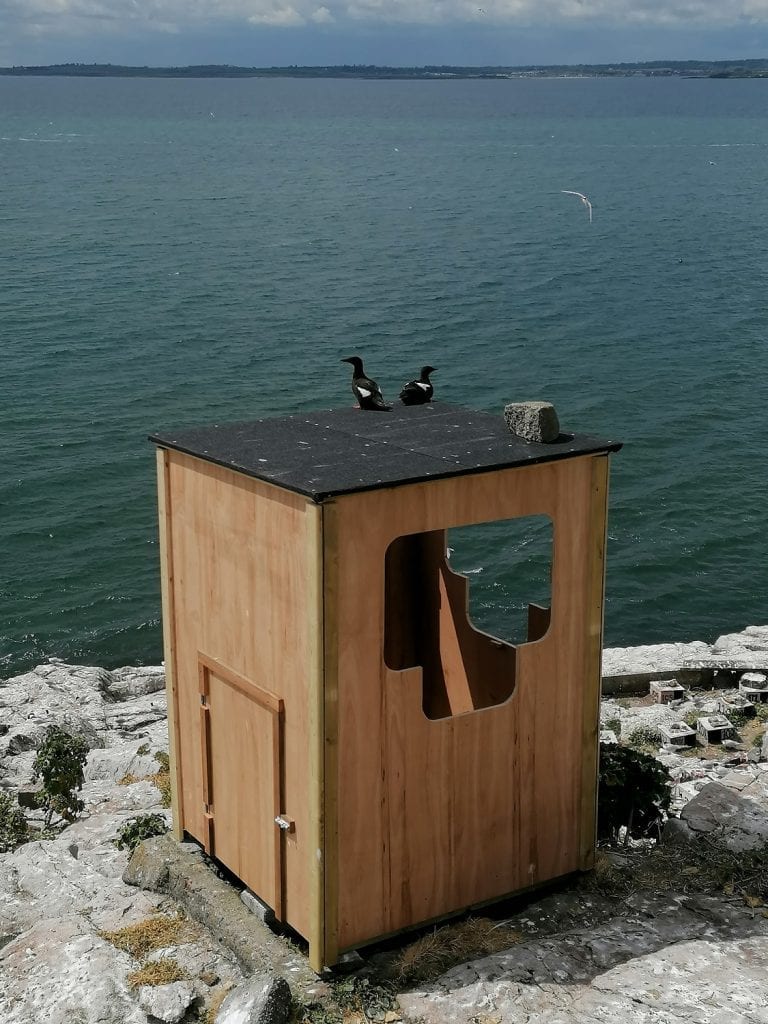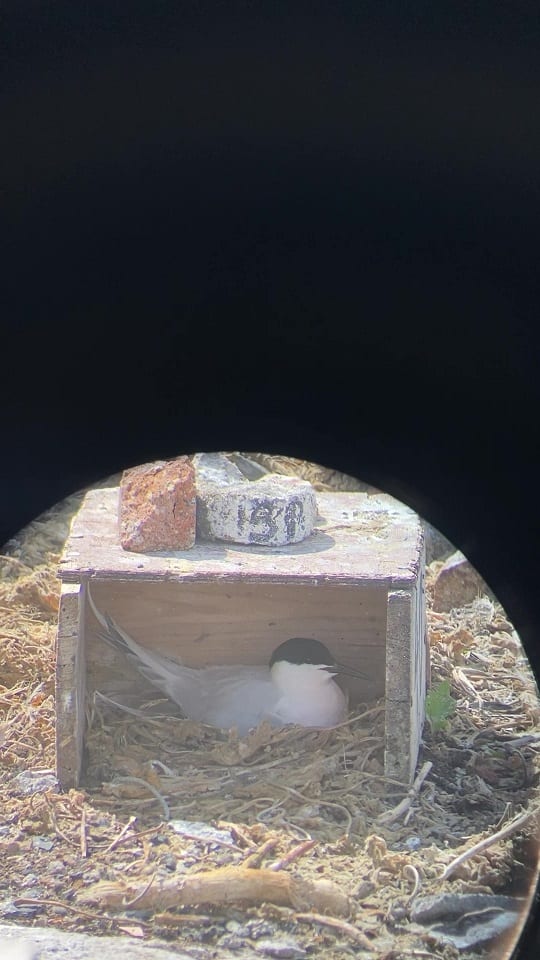Our wardens have been back on Rockabill for over a month now, with thanks to funding from the National Parks and Wildlife Service and the cooperation of the Commissioners of Irish Lights. See below to meet the 2021 Rockabill Team, and to hear about what they’ve been up to since arriving out on the island:
Meet The Wardens
Emma Tiernan
Emma is returning to Rockabill for her third season working as a tern warden with BirdWatch Ireland. Between seasons she has also worked in the BirdWatch offices, assisting our admin team with general administrative duties, membership and shop orders. She has also volunteered with BirdWatch Ireland on the East Coast Nature Reserve, the Dublin Bay Birds Project and the Dalkey Tern Project. Emma graduated with a B.Sc. in Zoology from Bangor University, Wales. She the continued her studies and completed a Master’s in Ecology. Outside of her work with BirdWatch she has worked as an ecologist and volunteered with Bat Conservation Ireland doing bat surveys, and has worked with Sea Watch Foundation, monitoring Bottlenose Dolphins in New Quay, Wales.
Alex Fink
Alex is here for the first time and absolutely eggs-cited about working with her favourite seabirds which are Terns! Having finished a PhD studying the migration of cancer cells, she decided that it would be amazing to combine her interest in migrating systems and her passion about seabirds! She is often found on seabird islands: Thus, she’s volunteered on the Farne Islands (where she fell in love with Arctic Terns) and on Helgoland, where she helped with bird ringing (she’s a very keen trainee bird ringer!). In addition, she’s part of the RSPB’s Project Puffin helping identify the fish brought to the Puffins’ breeding colonies.
She enjoys studying the behaviour of the nesting birds on Rockabill and is very keen to find juicy migrant birds. She also regularly tweets about the Wardens’ work under her handle @alex_the_finch.

This is Micheáls first season as a tern warden on Rockabill with BirdWatch Ireland. He recently obtained a Master’s by research from University College Cork, working with their Marine Ecology Research Group to study the health and condition of Northern Gannets on Great Saltee. With a B.Sc. in Ecology and Environmental Biology, also from UCC, he has also conducted research on non-native Sika Deer, and volunteers with the Irish Hen Harrier Winter Survey. Micheál spends much of his free time bouldering on the islands granite, and spends his evenings “serenading” the islands birds with his banjo (the other wardens barred him from playing inside).
 All three of our Rockabill wardens are very excited for what the 2021 season will bring.
All three of our Rockabill wardens are very excited for what the 2021 season will bring.
Preparing the Island
After arriving at Rockabill at the end of April, project manager Dr Stephen Newton and the wardens quickly began preparing the island for the arrival of the Common, Roseate, and Arctic terns. The main island (the ‘Rock’) is covered from end to end in tree mallow. This densely growing plant takes up so much of the ground area on the island that there is no room for any nests. Its swift removal was first on the wardens long list of priorities. Thankfully, with the help of some volunteers, leaders from the Skerries Sea Scouts and some friendly kayakers, this tedious task was completed in good time.
Tree Mallow being cut down with the help of our kind volunteers.
The “after shot” of what the island looks like when the Tree Mallow is removed and there is room for our nesting Terns.
With the tree mallow cleared, the next big tasks were preparing the nest boxes for the arriving Roseate Terns, and putting up the hides to allow the wardens to keep a close eye on them. After taking the nest boxes out of storage, they were counted and any broken boxes were repaired. This year 100 brand new nest boxes were added to the collection, to replace some older boxes that could not be repaired. In total 892 Roseate Tern nest boxes were placed around the island, a big increase from 832 nest boxes placed in previous years.
 Just a small fraction of the amount of nest boxes that are carefully placed around the island for the Roseate Terns to nest in.
Just a small fraction of the amount of nest boxes that are carefully placed around the island for the Roseate Terns to nest in.
Next came the hides, which the wardens erected at four vantage points across the island, so that they could observe the nesting terns throughout the season. These were weighed down with heavy rocks in order to prevent them from being blown away in any storms (or so the wardens thought!). Soon after, Steve headed back to the mainland, leaving the three wardens alone for the first time, with only each other and the terns, now increasing in numbers, for company.
Dr Stephen Newton, Emma Tiernan and Micheál Fitzgerald putting up one of the Hides for the season.
New Hides brought to the Rock
The wardens set about placing nest boxes around the island, a task that became increasingly difficult due to ever increasing winds. Before the placement of boxes could be completed, some seriously stormy weather forced the wardens to spend a frustrating few days’ inside, hoping their carefully placed boxes and hides would be waiting just where they left them. One morning the wardens awoke to find disaster had struck; the first casualties of the season had occurred! Two hides had been smashed to pieces by the fierce winds and left lying asunder about the island. So much for their heavy rocks! The wardens quickly collected what remained of their hides and stored them away, with the hopes of repairing them when the weather calmed down.
Left in pieces! One of the hides that did not survive the high winds of the storm.
 High waves from the storm hitting the Bill.
High waves from the storm hitting the Bill.
Thankfully, the storm eventually receded without the loss of any nest boxes, and the wardens were able to resume their work placing the remainder of these across the island. And just in the nick of time! Not long after the poor weather had ended, the first common tern egg was found, on the 13th of May, and the first roseate soon after on the 14th.
 Panoramic shot of some of the nest boxes placed on the West side of the Rock.
Panoramic shot of some of the nest boxes placed on the West side of the Rock.
Luckily, Dr Stephen Newton had organised for two brand new hides to be delivered. These were set to replace one of the hides that had been destroyed as well as a hide that had been lost in a storm during in the 2020 season (talk about bad luck striking twice). The wardens were able to recover all of the pieces from one hide and it was repaired and once again placed in its original spot. This time the team were not taking any chances! As well as being weighted down win heavy rocks, the hides were tied down with rope to give them extra security. So far this has worked and we have not had any more casualties.
 One of the new hides being enjoyed by some Black Guillemots (as well as the wardens) in much sunnier weather.
One of the new hides being enjoyed by some Black Guillemots (as well as the wardens) in much sunnier weather.
Lots of Birds & Lots of Nests
The wardens spent most of the month of May counting Roseate Tern, Common Tern and Arctic Tern nests in their study areas. As well as this, they have made good use of the new hides (and the surviving ones) to carry out ring-reading on as many birds as possible. Every year the Rockabill team does its best to try to ring as many birds as possible. Each ring has an individual code that is specific to that bird. By reading these rings through a scope or binoculars, we can learn about where the birds have come from, how old they are, if they nest in the same areas every year, if they mate with the same partner each year, how their nesting success changes as they get older, and if we’re lucky we might spot a bird that has been seen away from Rockabill and learn about their migration too.
 A Roseate Tern inside a nest box. Photo taken through the scope during one of the many ring-reading sessions in the hide.
A Roseate Tern inside a nest box. Photo taken through the scope during one of the many ring-reading sessions in the hide.
That’s all the news from Rockabill at the moment. Stay tuned and we will keep you updated about all that comes from the 2021 season.
– Alex Fink Micheál Fitzgerald and Emma Tiernan
This year’s work to protect and monitor the terns and other breeding seabirds on Rockabill would not be possible without support from the National Parks and Wildlife Service and the cooperation of the Commissioners of Irish Lights.
To revisit news and blogs from previous years on Rockabill, click the link here.




 All three of our Rockabill wardens are very excited for what the 2021 season will bring.
All three of our Rockabill wardens are very excited for what the 2021 season will bring.

 Just a small fraction of the amount of nest boxes that are carefully placed around the island for the Roseate Terns to nest in.
Just a small fraction of the amount of nest boxes that are carefully placed around the island for the Roseate Terns to nest in.

 High waves from the storm hitting the Bill.
High waves from the storm hitting the Bill. Panoramic shot of some of the nest boxes placed on the West side of the Rock.
Panoramic shot of some of the nest boxes placed on the West side of the Rock. One of the new hides being enjoyed by some Black Guillemots (as well as the wardens) in much sunnier weather.
One of the new hides being enjoyed by some Black Guillemots (as well as the wardens) in much sunnier weather.  A Roseate Tern inside a nest box. Photo taken through the scope during one of the many ring-reading sessions in the hide.
A Roseate Tern inside a nest box. Photo taken through the scope during one of the many ring-reading sessions in the hide. 